Chickens were domesticated thousands of years ago, and humans have developed hundreds of separate breeds. Whether breeders are looking for a productive egg-layer, a hefty dressed bird for the table, or even a pet to show off in the garden – there’s a chicken breed out there for everyone. Here is a handy guide to the different large fowl breeds recognized by the American Poultry Association.
Table of Contents
American Class
Buckeye
This American chicken breed was first developed in 1896 by Nettie Metcalf of Warren, Ohio. Born and bred in the Buckeye state, the Buckeye chicken is primarily a mahogany color – and its plumage resembles the deep chestnut color of buckeye seeds.
They are similar in color to the Rhode Island Red, but the Buckeye breed actually came first –Nattie sent some of her Buckeyes to Rhode Island improve their breeding stock. Unlike the Rhode Island Red, the Buckeye is the only American breed with a pea comb, and they have yellow skin and produce brown eggs.
This chicken breed is rare in the United States, with less than 1,000 individuals remaining. They’re generally found on smaller hobby farms, as they are a hardy cold-weather bird that is good for both producing meat and for laying eggs.
Quick Buckeye Facts
- Country of Origin: United States
- Weight: Males 9 lbs, Females 6.5 lbs
- Main Purpose: Eggs, Meat
- Egg Production: 150-200 eggs per year
- Meat Growing Time: 5-6 months
- Recognized Color Varieties: One Variety Only
- Bantam Variety: One Variety Only
Chantecler
In the early 20th century, Canada did not have a chicken breed of their own. Instead, Canadians relied on American and European imports. In 1907, a Trappist monk established his own breed of chicken that could thrive in the harsh Canadian environment to help feed the people during the long winters.
A hardy cold-weather breed, the Chantecler is primarily white (although there is a distinct Partridge type with red plumage) with a yellow skin and beak, and produces brown eggs. They have a small single comb, and small wattles so that they don’t freeze in the cold.
Today, Chanteclers are considered a critically endangered heritage breed, and they are mostly found in small breeding operations and hobby farms.
Quick Chantecler Facts
- Country of Origin: Canada
- Weight: Males 9 lbs, Females 6.5 – 7.5 lbs
- Main Purpose: Eggs, Meat
- Egg Production: 150 – 200 eggs per year
- Meat Growing Time: 4+ months
- Recognized Color Varieties: White, Partridge
- Bantam Variety: White, Partridge
Delaware
This breed of broiler chicken (originally named the Indian River) was created in 1940 by crossing Barred Plymouth Rock roosters with New Hampshire hens.
Occasionally, the offspring would be white (although they are genetically silver). Eventually, these crosses became a new breed of their own – the Delaware.
Delaware chickens have white plumage with “light black barring on the ends of the hackle, wings, and tails.” They have large red single combs and wattles, yellow skin, and produce large to jumbo brown eggs.
Primarily raised for meat in the 40’s and 50’s, the breed fell out of favor as the fast-growing Cornish-Rock grew in popularity. Today, the Delaware is still raised for meat or showing, but the breed is relatively rare, and is listed as critically endangered by the Livestock Conservancy.
Quick Delaware Facts
- Country of Origin: United States
- Weight: Males 8.5 lbs, Females 6.5 lbs
- Main Purpose: Meat, Eggs
- Egg Production: 150-200 eggs per year
- Meat Growing Time: 3 – 4 months
- Recognized Color Varieties: One Variety Only
- Bantam Varieties: One Variety Only
Dominique
The Dominique (also known as the Dominicker or Pilgrim Fowl) is widely regarded as America’s oldest chicken breed. During Colonial times, settlers brought chickens with them from Southern England – the descendants of which became the Dominique breed.
These dual-purpose chickens became popular, raised for meat and eggs, and their feathers provided stuffing for pillows and mattresses.
Dominique chickens have a single rose comb, heavy plumage with striped barring, yellow skin, and lay brown eggs. They are hardy, and well-suited for harsher climates.
Quick Dominique Facts
- Country of Origin: United States/Canada
- Weight: Males 7 lbs, Females 5 lbs
- Main Purpose: Eggs, Meat
- Egg Production: 200 – 250+ eggs per year
- Meat Growing Time: 4+ months
- Recognized Color Varieties: One Variety Only
- Bantam Varieties: One Variety Only
Holland
In the 1950s, New Jersey breeders crossed several established American breeds with light imported chickens from Holland to produce white eggs instead of brown.
Two varieties of Holland chickens were born – the White Holland (when imports from Holland were crossed with the White Leghorn, Rhode Island Red, New Hampshire, and Lamona) and the Barred Holland (crosses with the White Leghorn, Barred Plymouth Rock, Australorp, and Brown Leghorn).
The Holland looks very similar to Plymouth Rocks and Dominiques, except the Holland has a single comb and lays white eggs.
Quick Holland Facts
- Country of Origin: United States
- Weight: Males 7.5 – 8.5 lbs, Females 5.5 – 6.5 lbs
- Main Purpose: Eggs, Meat
- Egg Production: 200 – 240 eggs per year
- Meat Growing Time: 3 – 4 months
- Recognized Color Varieties: Barred, White
- Bantam Varieties: Barred, White
Java
The Java is another early American breed developed in the early 19th century, second only to the Dominique. It’s named after the isle of Java, an island in Indonesia, as the breed was created from chickens of Asian descent. Although, nobody knows for sure exactly what breeds the Java descended from – just that they were likely of Asian origin.
Today they are listed as critically endangered, with fewer than 500 breeding flocks existing. This dual purpose bird appears in four variations, although only two are recognized by the APA: the Black, and the Mottled. Their plumage varies depending on type – the Black variety is a uniform black hue with a green sheen, the Mottled is black with white markings on the tips of the feathers and striking red eyes. (source)
Quick Java Facts
- Country of Origin: United States
- Weight: Males 8-9.5 lbs, Females 6.5 – 7.5 lbs
- Main Purpose: Eggs, Meat
- Egg Production: 200 – 240 eggs per year
- Meat Growing Time: 4 – 7 months
- Recognized Color Varieties: Black, Mottled
- Bantam Varieties: Black, Mottled
Jersey Giant
One of the largest heritage chicken breeds, the Jersey Giant is a stout, hardy chicken developed in New Jersey during the 1880s.
Despite their large final size, they have a slower growing time than other chicken breeds. This makes them less suited to be a commercial meat bird (although this was their main purpose when they were first developed).
However, they have a fairly long laying season, and are typically a cold-hardy bird. Jersey Giants come in three varieties recognized by the APA – black, white, and blue (although others exist). They have a single comb and yellow skin, and they lay brown eggs.
Quick Jersey Giant Facts
- Country of Origin: United States
- Weight: Males 13 lbs, Females 10 lbs
- Main Purpose: Eggs, Meat
- Egg Production: 200 – 240 eggs per year
- Meat Growing Time: 9 months
- Recognized Color Varieties: Black, White, Blue
- Bantam Varieties: Black, White
New Hampshire
The New Hampshire chicken is the official State Poultry of the state of New Hampshire, thanks to some enterprising fourth graders in 2018.
These dual-purpose chickens originated in New England out of a particular strain of Rhode Island Reds in the early 20th century – breeders sought a bird that would grow feathers faster and mature more quickly.
They are generally a lighter red than their Rhode Island cousins, with yellow skin and a medium-size comb with five points. They are clean-legged, and they have bright red wattles and earlobes.
New Hampshire chickens make excellent meat birds, but they also provide a plethora of eggs as well. These heritage chickens usually make a good addition to any backyard homestead.
Quick New Hampshire Facts
- Country of Origin: United States
- Weight: Males 8.5 lbs, Females 6.5 lbs
- Main Purpose: Meat, Eggs
- Egg Production: 200 eggs per year
- Meat Growing Time: 4 months or less
- Recognized Color Varieties: One Variety
- Bantam Varieties: One Variety
Plymouth Rock
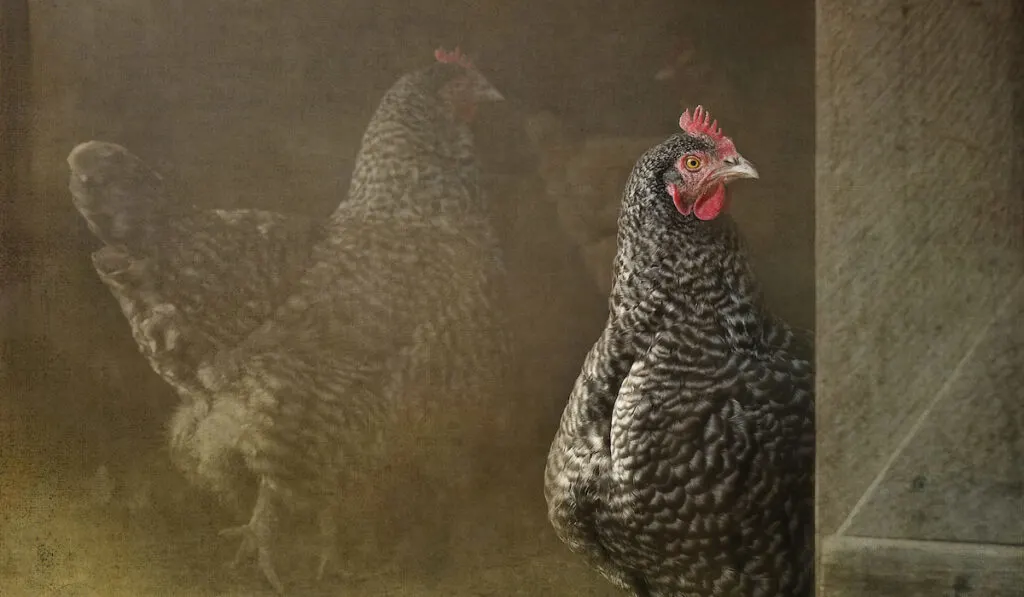
This heritage breed is commonly raised commercially for eggs and meat, as it is a cold-hardy and docile bird. It first appeared in Massachusetts (although nowhere near Plymouth Rock) in the late 1800s.
The breed began by crossing Black Javas with a single-combed barred bird – and keeping only those with clean yellow legs and barred feathers as breeding stock.
These birds have a striking appearance, and they come in several varieties. Barred Plymouth Rocks have standard barred plumage, and this is one of the most common color variations. With their bright red single combs and well-rounded wattles, they also have yellow skin and lay brown eggs.
Quick Plymouth Rock Facts
- Country of Origin: United States
- Weight: Males 7.5 lbs, Females 6.5 lbs
- Main Purpose: Meat, Eggs
- Egg Production: 200 eggs per year
- Meat Growing Time: 3 – 4 months
- Recognized Color Varieties: Barred, White, Buff, Silver Penciled, Partridge, Columbian, Blue
- Bantam Varieties: Barred, Black, Blue, Buff, Columbian, Partridge, White, Silver Penciled, Black
Rhode Island Red

The Rhode Island Red chicken is the official State Bird of Rhode Island – a well-deserved honor that no other chicken breed can claim.
These utilitarian birds were bred for function, rather than a fancy form. The Rhose Island Red heritage chickens are excellent dual-purpose meat and egg layers, but are also used in commercial operations as well.
Like the name suggests, the plumage of the Rhode Island Red is a rich lustrous red color with a black tail. They come in single and rose comb varieties, although both have clean legs, yellow skin, and lay brown eggs.
Crossing these birds with other breeds can result in some truly prolific egg-laying capabilities – some crossbreeds can produce more than 300 eggs per year!
Quick Rhode Island Red Facts
- Country of Origin: United States
- Weight: Males 8.6 lbs, Females 6.6 lbs
- Main Purpose: Meat, Eggs
- Egg Production: 280-300 eggs per year
- Meat Growing Time: 5 – 6 months
- Recognized Color Varieties: Single Comb and Rose Comb
- Bantam Varieties: Single Comb and Rose Comb
Rhode Island White
The Rhode Island White is a separate breed from the Rhode Island Red, and while they are not nearly as popular, they should still be recognized as a good dual-purpose bird. Developed by crossing Partridge Cochins, White Wyandottes, and Rose-Comb White Leghorns, the result was a hardy bird suitable for meat and egg production.
The Rhode Island White can be used to create red sex-links with the RIR (Cinnamon Queen and Gold Comet breeds), which are used in commercial brown egg production. The Rhode Island White has white plumage, medium-sized wattles, and a rose comb.
Quick New Hampshire Facts
- Country of Origin: United States
- Weight: Males 8.5 lbs, Females 6.5 lbs
- Main Purpose: Meat, Eggs
- Egg Production: 220-280 eggs per year
- Meat Growing Time: 3 – 4 months
- Recognized Color Varieties: Rose Comb
- Bantam Varieties: One Variety Only
Wyandotte
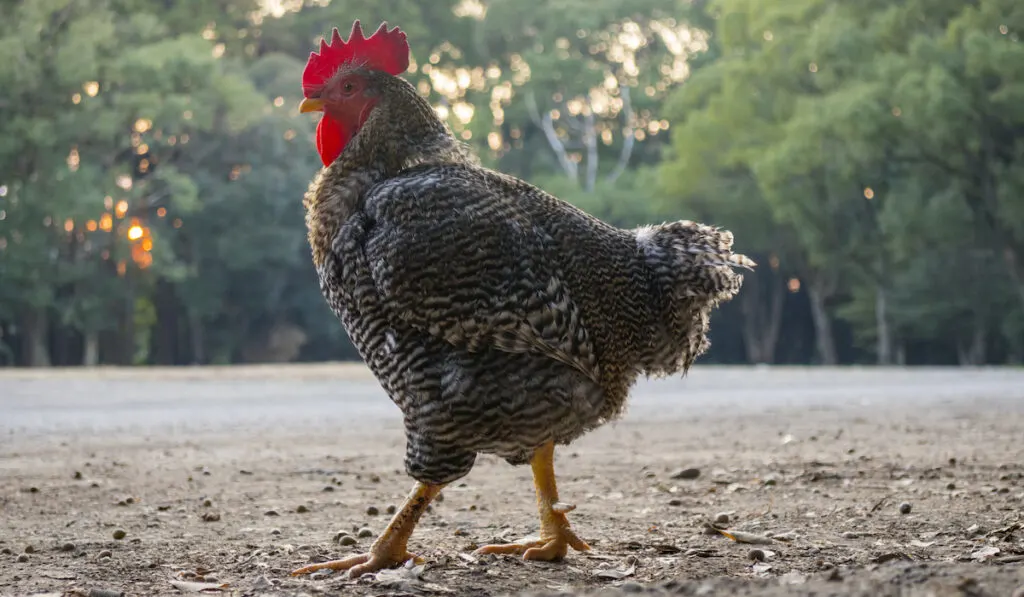
These attractive heritage chickens have captured the hearts of fanciers for over a hundred years. Developed from early imported breeds, the Wyandotte has a rather mysterious history, as there are no written records for describing its origins.
The first variety, the Silver Laced Wyandotte, appeared in the 1870s, bred from stock from four different breeders (residing in New York, Michigan, and Massachusetts).
Today, there are 9 different varieties of the Wyandotte recognized by the APA, but many more are recognized in other countries. The most common color is still the Silver Lace variety, with striking black markings on top of white plumage. These birds also have rose combs, clean legs, and lay brown eggs.
Quick Wyandotte Facts
- Country of Origin: United States
- Weight: Males 8 lbs, Females 6 lbs
- Main Purpose: Meat, Eggs
- Egg Production: 200 eggs per year
- Meat Growing Time: 3-4 months
- Recognized Color Varieties: Silver Laced, Golden Laced, White, Black, Buff, Partridge, Silver Penciled, Columbian, Blue
- Bantam Varieties: Black, Blue, Buff, White, Columbian, Buff Columbian, Silver Laced, Golden Laced, Silver Penciled, Partridge
Asiatic Class
Brahma
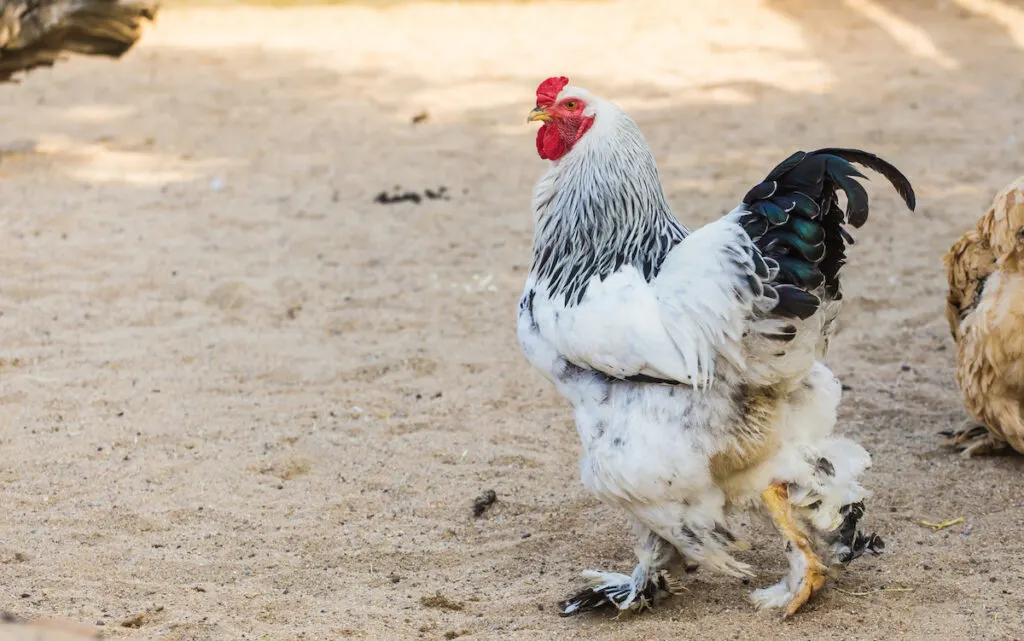
The origins of the Brahma are somewhat unknown, but historians believe they probably come from Asiatic birds such as the Chittagong of India and Chinese Shanghai chickens. Developed in the 1850s in California, the Brahma is a large fancy bird with a handsome appearance.
They come in several standard varieties (and several nonstandard varieties as well) including black, buff, dark, white, and light. A feather-legged breed, they also have red wattles and earlobes, and a medium sized pea comb. They grow rather quickly, and reach a large size, which makes them good meat birds.
Quick Brahma Facts
- Country of Origin: United States
- Weight: Males 12.1 lbs, Females 9.9 lbs
- Main Purpose: Meat, Eggs
- Egg Production: 150 eggs per year
- Meat Growing Time: 2+ months
- Recognized Color Varieties: Light, Dark, Buff
- Bantam Varieties: Light, Dark, Buff
Cochin

These showy birds are known for their exceptional fluffy feathers and puffy tails – they look like walking pillow stuffing!
Breeders in the late 1800s began selecting chickens for aesthetic traits, rather than production capabilities (a period of time referred to as the “Hen Craze”). As a result, imported Chinese Shanghai Fowl were selected for their extra fluffy feathers – and the Cochin was born.
Like other fancy breeds, they come in a wide variety of colors and varieties including white, barred, black, white, blue, and buff (among others).
Cochins have feathered legs, single combs, and long wattles and earlobes. While they can be too slow to mature for a commercial operation, they are large and cold-hardy, and decent winter layers.
Quick Cochin Facts
- Country of Origin: China
- Weight: Males 10.5 lbs, Females 9 lbs
- Main Purpose: Meat and Eggs, Ornamental
- Egg Production: 100+ eggs per year
- Meat Growing Time: 4 – 6 months
- Recognized Color Varieties: Buff, Partridge, White, Black, Barred, Silver Laced, Golden Laced, Blue, Brown
- Bantam Varieties: White, Black, Barred, Birchen, Blue, Brown Red, Buff, Buff Columbian, Splash, Columbian, Golden Laced, Lemon Blue, Mottled, Red, Silver Laced, Partridge, Brown
Langshan
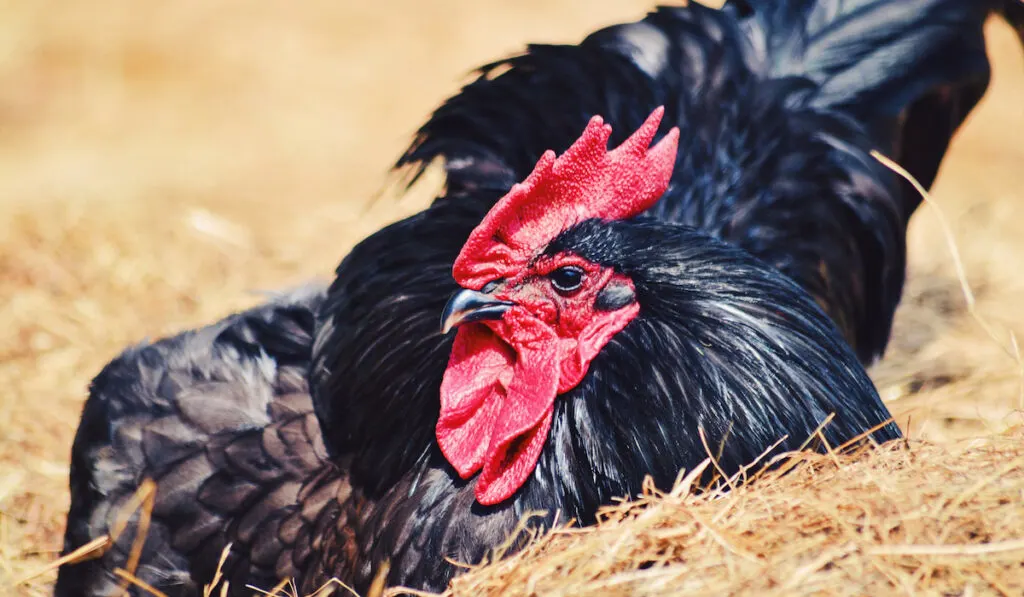
These striking birds from China are the tallest of the non-game breeds. These dual-purpose chickens are quite showy – roosters are tall, and possess a distinctive “u” shaped arch between their necks and their tails.
This feather-legged bird comes in three varieties: black, blue, and white. They have single combs and red earlobes and wattles.
They are somewhat slow to grow, but they produce a decent amount of brown eggs with a plum-colored bloom per year. They are a somewhat rare heritage breed, and the Livestock Conservancy has placed them on the “threatened” list.
Quick Langshan Facts
- Country of Origin: China
- Weight: Males 9.5 lbs, Females 7.5 lbs
- Main Purpose: Meat and Eggs, Ornamental
- Egg Production: 150-200 eggs per year
- Meat Growing Time: 4 – 6 months
- Recognized Color Varieties: Black, Blue, White
- Bantam Varieties: Black, Blue, White
Continental Class
Barnevelder
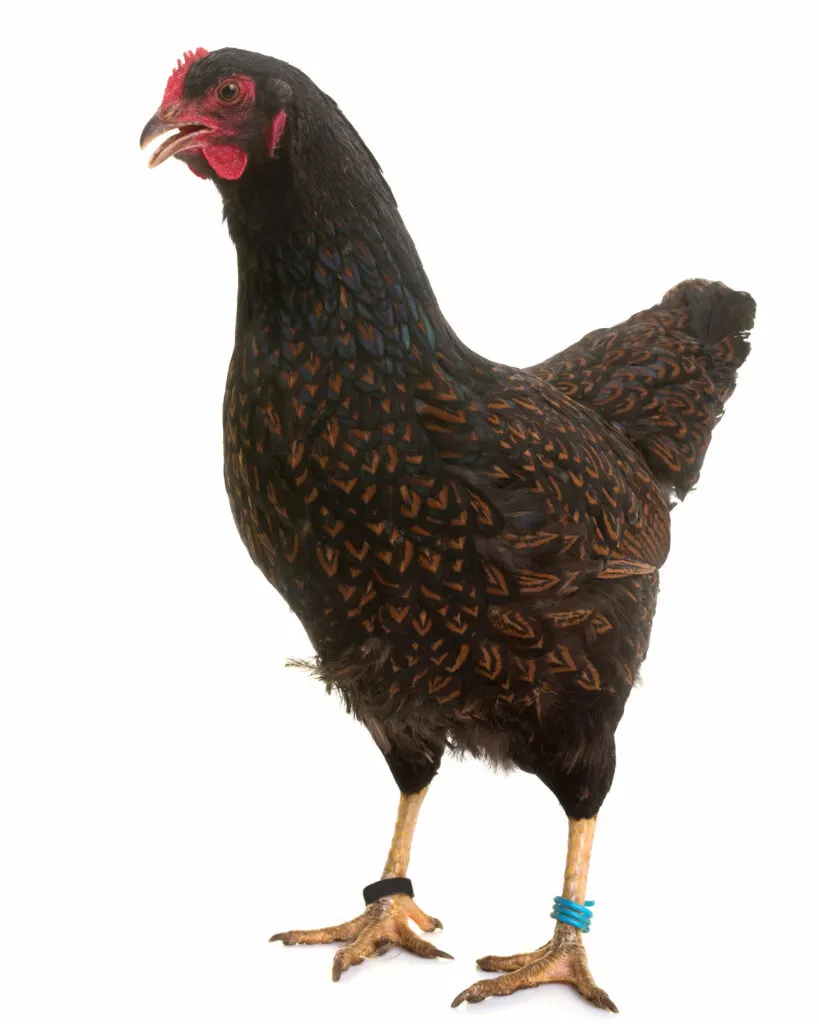
These showy birds from the Netherlands have striking black plumage with a greenish hue and intricate bronze lacing. They lay uniquely colored eggs – dark brown with a coppery tint to them.
Barnvelders are an older European breed, developed in the 1920s. However, they were not introduced into the APA until 1991.
Breeders were looking to create a chicken that would lay eggs during the long northern European winters. Barnvelders are cold-hardy and docile, and are good layers. They have well-defined red combs and medium sized wattles.
Quick Barnevelder Facts
- Country of Origin: Holland
- Weight: Males 7.2 lbs, Females 5.7 lbs
- Main Purpose: Eggs, Ornamental
- Egg Production: 175 – 200 eggs per year
- Recognized Color Varieties: One Variety Only
- Bantam Varieties: None
Campine
The ornamental Campine chicken is known for its somewhat distinctive plumage – males generally possess “hen-feathering.” That is, he doesn’t develop the same long tail feathers of other breeds. In fact, exceptionally long sickle feathers or saddle feathers will even be penalized at shows.
An ancient breed from Belgium, the Campine resembles the Brackel, which is an old chicken breed that dates back to the early 1400s. They are also descended from the Egyptian Fayoumis, which were probably brought to Europe by the Ancient Romans.
Campines come in silver and golden varieties. Despite the fact that they’re mostly known as ornamental birds in the US, they also make good layers.
Quick Campine Facts
- Country of Origin: Belgium
- Weight: Males 6 lbs, Females 5.7 lbs
- Main Purpose: Ornamental, Eggs
- Egg Production: 150+ eggs per year
- Recognized Color Varieties: Silver, Golden
- Bantam Varieties: Golden, Silver
Crèvecœur
Like the Houdan, the Crevecoeur is a striking bird with a v-shaped comb and impressive crown tuft. This ancient breed from France developed as a stylish bird that was raised for meat and eggs, but is mostly ornamental today. While they tend to be smaller than the birds of old, these birds still lay a decent amount of eggs for a backyard hobbyist.
The Crevecoeur is a black bird with impressive fluffy plumage. They tolerate the cold well, but their crest feathers may be susceptible to freezing in particular cold and wet weather. They have red combs and wattles, and lay medium-sized white eggs.
Quick Crevecoeur Facts
- Country of Origin: France
- Weight: Males 6.5 lbs, Females 5.5 lbs
- Main Purpose: Meat and Eggs, Ornamental
- Egg Production: 150+ eggs per year
- Meat Growing Time: 4 – 6 months
- Recognized Color Varieties: Black
- Bantam Varieties: Black
Faverolles
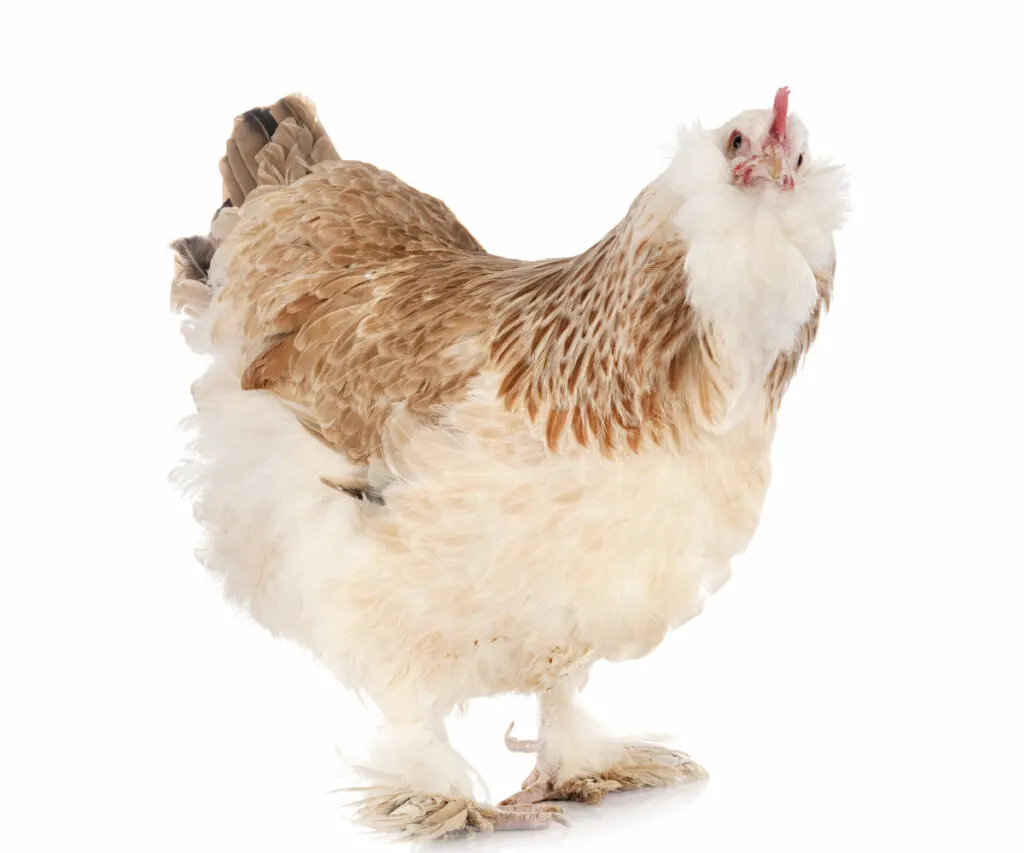
These fluffy French birds have mysterious origins. Nobody is quite sure where they came from, but it’s suspected that they possess a mix of Dorking, Houdan, Brahma, Langshan and Cochine blood (just to name a few).
These quirky birds are known to be fairly easygoing towards humans, which makes them good candidates for backyard operations (although they can be aggressive towards other chicken breeds).
Faverolles come in several varieties, including black, buff, and blue, but only salmon and white are recognized by the APA.
They have five toes with light leg feathering, fluffy neck feathers (giving them the appearance of a beard and neck muff), and prominent red combs. They are known for their good winter laying abilities and produce a sizeable amount of medium to large brown eggs.
Quick Faverolle Facts
- Country of Origin: France
- Weight: Males 11 lbs, Females 9.4 lbs
- Main Purpose: Meat and Eggs, Ornamental
- Egg Production: 180-200 eggs per year
- Meat Growing Time: 4 – 6 months
- Recognized Color Varieties: Salmon, White
- Bantam Varieties: Salmon, White
Hamburg
This old European bird was carefully developed by the Dutch and the British to be a good laying chicken. They are suitable for most backyard operations, but they are excellent fliers – care must be taken to contain them or protect them from predators.
A striking bird, they come in several varieties including golden and silver-spangled, golden and silver-penciled, black, and white. They have large rose combs that can cover their heads, and moderately large white earlobes. They are prolific layers of relatively small white eggs.
Quick Hamburg Facts
- Country of Origin: Holland
- Weight: Males 5 lbs, Females 3.7 lbs
- Main Purpose: Eggs
- Egg Production: 200 – 250+ eggs per year
- Recognized Color Varieties: Golden Spangled, Silver Spangled, Golden/Silver Penciled, Black, White
- Bantam Varieties: Black, Golden Penciled, Golden Spangled, White, Silver Penciled, Silver Spangled
Houdan
The Houdan is an ancient breed from France, originally developed to provide the people of Paris with eggs and meat. These showy birds have distinctive tufts of plumage on tops of their heads, as well as an interesting v-shaped comb.
Houdan’s are a good choice for hobby breeders looking to show a dual-purpose bird, and would provide a stylish addition to any backyard flock.
Houdan chickens come in two varieties: mottled and white. Mottled birds are quite striking, with primarily black plumage splashed with white, and a white face. They have five toes, hidden earlobes, and lay white eggs.
Quick Houdan Facts
- Country of Origin: France
- Weight: Males 6 lbs, Females 5 lbs
- Main Purpose: Meat and Eggs, Ornamental
- Egg Production: 50 – 100 eggs per year
- Meat Growing Time: 4 – 6 months*
- Recognized Color Varieties: Mottled, White
- Bantam Varieties: Mottled, White
La Fleche
These French “devil birds” have striking black plumage, and a unique v-shaped comb that stands out from the tops of their heads – resembling devil horns. They are known in France for their ability to provide a sizeable amount of breast meat, as well as a decent amount of eggs.
The La Fleche chicken is solid black, with bright red combs and wattles. They have large white earlobes and lay medium to large white eggs.
Quick La Fleche Facts
- Country of Origin: France
- Weight: Males 8 lbs, Females 6.5 lbs
- Main Purpose: Meat, Eggs
- Egg Production: 200+ eggs per year
- Meat Growing Time: 4 – 6 months
- Recognized Color Varieties: Black
- Bantam Varieties: Black
Lakenvelder

The Lakenvelder is a stunning chicken breed from Holland and Germany. They have striking white plumage, with impressive black tails and black feathers covering their heads. Males have impressive red combs with five distinct points.
Lakenvelder hens are good layers, and can make a good choice for a backyard enthusiast interested in showing. These impressive birds are suitable for the novice chicken hobbyist. They have red combs and wattles, small white earlobes, and lay medium sized white eggs.
Quick Lakenvelder Facts
- Country of Origin: Holland and Germany
- Weight: Males 5.5 lbs, Females 4.5 lbs
- Main Purpose: Eggs, Ornamental
- Egg Production: 150-200 eggs per year
- Recognized Color Varieties: One variety only
- Bantam Varieties: One variety only
Maran
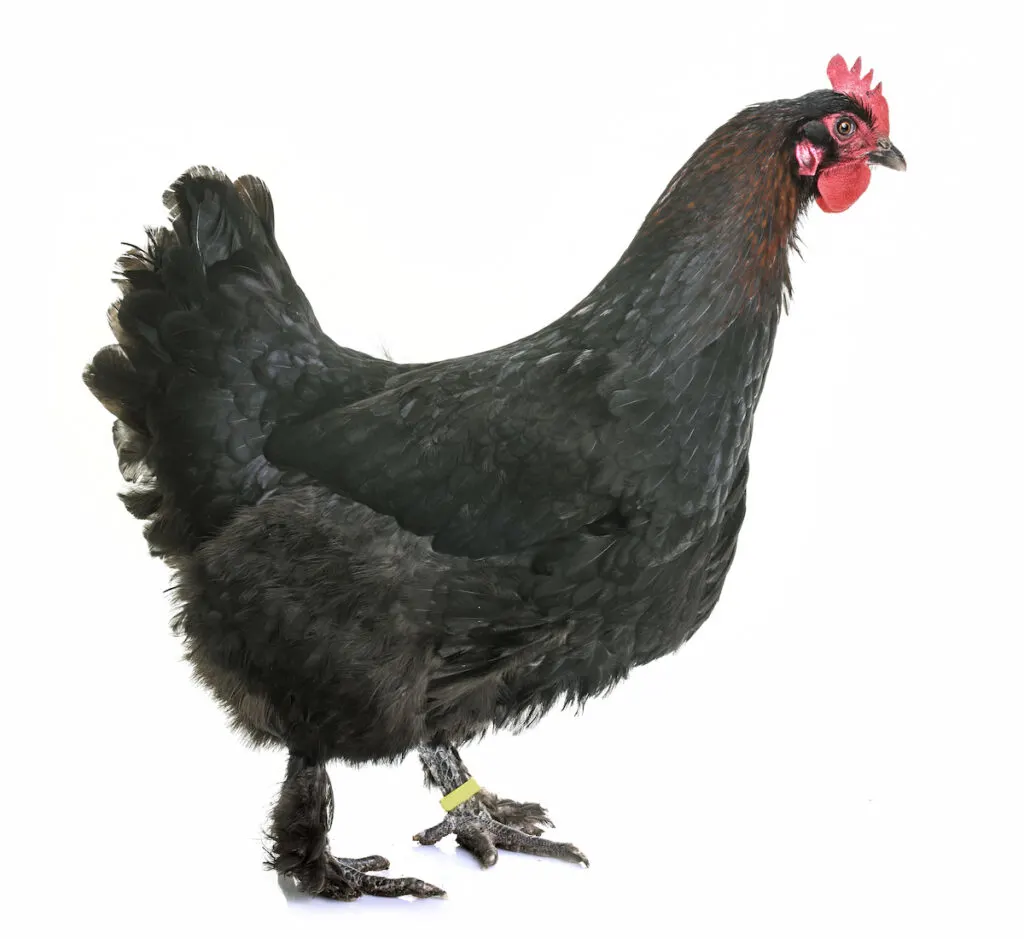
This relatively new chicken breed was developed in France. While they were imported to the United Kingdom in the 1930s, they didn’t reach the US until after 2000.
Marans are a larger breed with larger-sized wattles and a single upright comb. Only the feather-legged variety is recognized by the APA.
The cuckoo, or barred variety, is commonly offered by larger hatcheries. While this variety is recognized in France, it does not yet have APA approval.
Marans lay the darkest brown eggs of any breed – ranging from light chocolate to deep brown in color.
Some members of this breed also possess a gene that can make their shells very thick (10% of the egg’s weight). This is helpful for keeping contaminants and viruses out, but not as good for keeping surviving chicks in. Marans with this gene can have an increase in chick mortality from between 5% and 10%.
Quick Maran Facts
- Country of Origin: France
- Weight: Males 8.3 lbs, Females 4.4 lbs
- Main Purpose: Eggs, Meat
- Egg Production: 150-200 eggs per year
- Recognized Color Varieties: White, Black, Black Copper, Wheaten
- Bantam Varieties: None
Polish
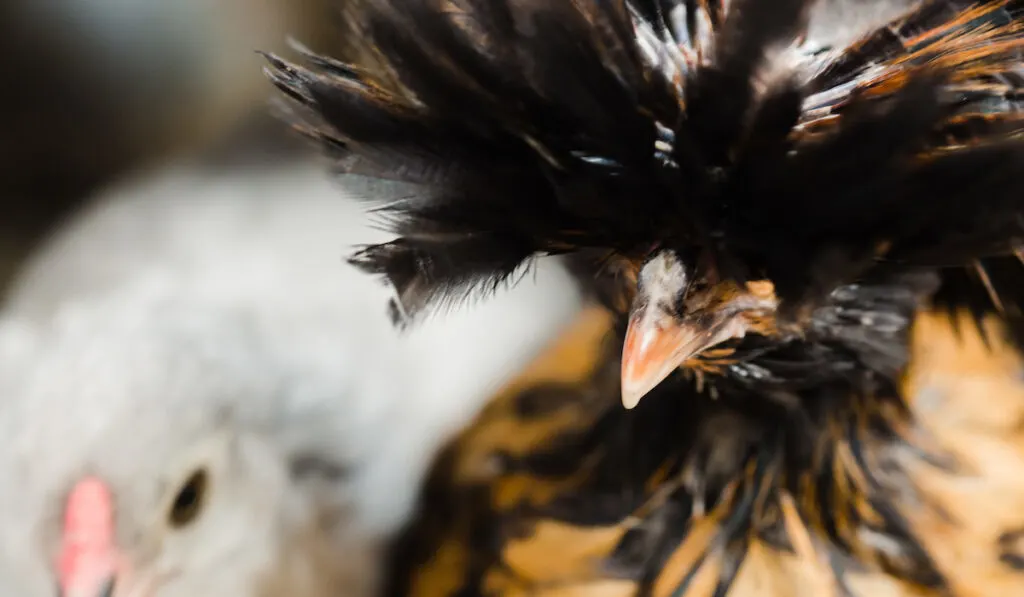
The Polish chicken is quite a sight to behold – it sports an impressively wild clump of feathers on top of its head. They may also have beards and muffs as well. The Polish isn’t actually from Poland, either, but rather from Holland. These somewhat goofy looking birds are often kept as pets, as they are docile and easily managed. However, they are also cold-hardy and good layers.
The Polish comes in many different varieties including white-crested black, and bearded and non-bearded white, golden, buff, and silver. Underneath all the fluff, they have small red combs and wattles.
Quick Polish Facts
- Country of Origin: Holland
- Weight: Males 6 lbs, Females 4.4 lbs
- Main Purpose: Eggs, Ornamental
- Egg Production: 200+ eggs per year
- Recognized Color Varieties: Bearded (Golden, Silver, White, Buff Laced) Non-bearded (White Crested Black, Golden, Silver, White, Buff Laced, White Crested Blue, Black Crested White)
- Bantam Varieties: Bearded (Golden, Silver, White, Buff Laced) Non-bearded (Golden, Silver, White Crested Black, White Crested Blue, Buff Laced, White)
Welsummer
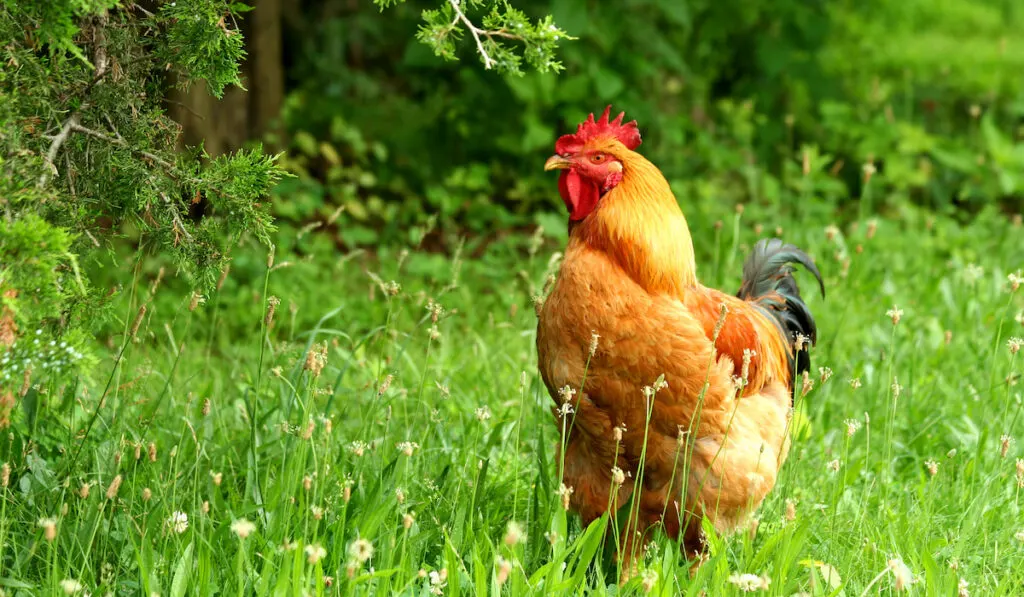
Admitted to the APA in 1991, the Welsummer is a relatively new breed of chicken in America. However, they were developed in Holland nearly one hundred years ago. Like the Barnvelder, they are a hardy cold-tolerant breed that often lays well during the colder months.
Welsummer chickens are the result of crossing Rhode Island Reds, Barnvelders, Partridge Leghorns, Cochins, and Wyandottes. They have black plumage on their bellies and tails, and orange-red feathers covering their heads, necks, and backs. The Welsummer has a prominent upright comb and medium-sized red wattles.
Quick Welsummer Facts
- Country of Origin: Holland
- Weight: Males 9.5 lbs, Females 7.5 lbs
- Main Purpose: Meat and Eggs, mainly ornamental
- Egg Production: 160+ eggs per year
- Meat Growing Time: 2 – 3 months
- Recognized Color Varieties: One variety only
- Bantam Varieties: Partridge
English Class
Australorp
The “national breed” of Australia is the dark dual-purpose Australorp. Early breeders imported Black Orpingtons into Australia from England in the late 1890s. Mixing some Minorcas, White Leghorns, Plymouth Rocks, Rhode Island Reds and Langshans created a solid egg-layer with a meaty body.
These solid-colored birds have black plumage all over, with a moderately large comb and wattles. They are cold-hardy and utilitarian, well-suited for backyard homestead operations.
Quick Australorp Facts
- Country of Origin: Australia
- Weight: Males 8 lbs, Females 6.5 lbs
- Main Purpose: Meat, Eggs
- Egg Production: 200 – 250+ eggs per year
- Meat Growing Time: 3 – 6 months
- Recognized Color Varieties: Black
- Bantam Varieties: Black
Cornish
The Cornish chicken is the foundation breed for the fast-growing and heavy commercial broilers that provide meat to millions of people each day. Cornish/Plymouth Rock crosses eat a lot of food, grow at breathtaking speeds, and don’t require a lot of space or activity.
The Cornish chicken began in England, and have a strong heritage from game birds. One unique characteristic is that the males and females have very similar body types – stocky, deep-breasted, and a sloping heart-shaped back. They do come in several different varieties (white is the most well-known variety for broilers) including dark, white, white laced red, and buff. They have small pea combs, and they lay brown eggs.
Quick Cornish Facts
- Country of Origin: England
- Weight: Males 10 lbs, Females 5.7 lbs
- Main Purpose: Meat
- Egg Production: 50 – 100+ eggs per year
- Meat Growing Time: 1 – 3 months (Cornish crossed chickens are generally ready for the table in 7-9 weeks).
- Recognized Color Varieties: Dark, White, White Laced Red, Buff
- Bantam Varieties: Black, Blue Laced Red, Buff, Dark, Mottled, Spangled, White, White Laced Red
Dorking
The Dorking developed in Britain as a tasty table bird, as it produced tender white meat with a good texture. However, its roots probably began in Italy during the time of the Roman Empire.
Once British colonists arrived in the Americas, the Dorking became a popular choice for small farms. They are a good dual-purpose heritage breed that has white skin and lays white eggs.
The Dorking comes in several varieties, including white, silver-gray, and colored. They have five toes on each clean-legged foot, and red combs and wattles. Their large single combs are often subject to freezing if they’re kept in very cold climates, so Dorking fanciers should keep that in mind.
Dorkings don’t scratch as much as other breeds, which makes them popular on backyard farms to this day.
Quick Dorking Facts
- Country of Origin: Great Britain
- Weight: Males 9.5 lbs, Females 9 lbs
- Main Purpose: Meat and Eggs
- Egg Production: 150 eggs per year
- Meat Growing Time: 4 – 6 months
- Recognized Color Varieties: Single Comb (Silver Gray, Colored, Cuckoo, Red) Rose Comb (Cuckoo, White)
- Bantam Varieties: Single Comb (Silver Gray, Colored) Rose Comb (White)
Orpington
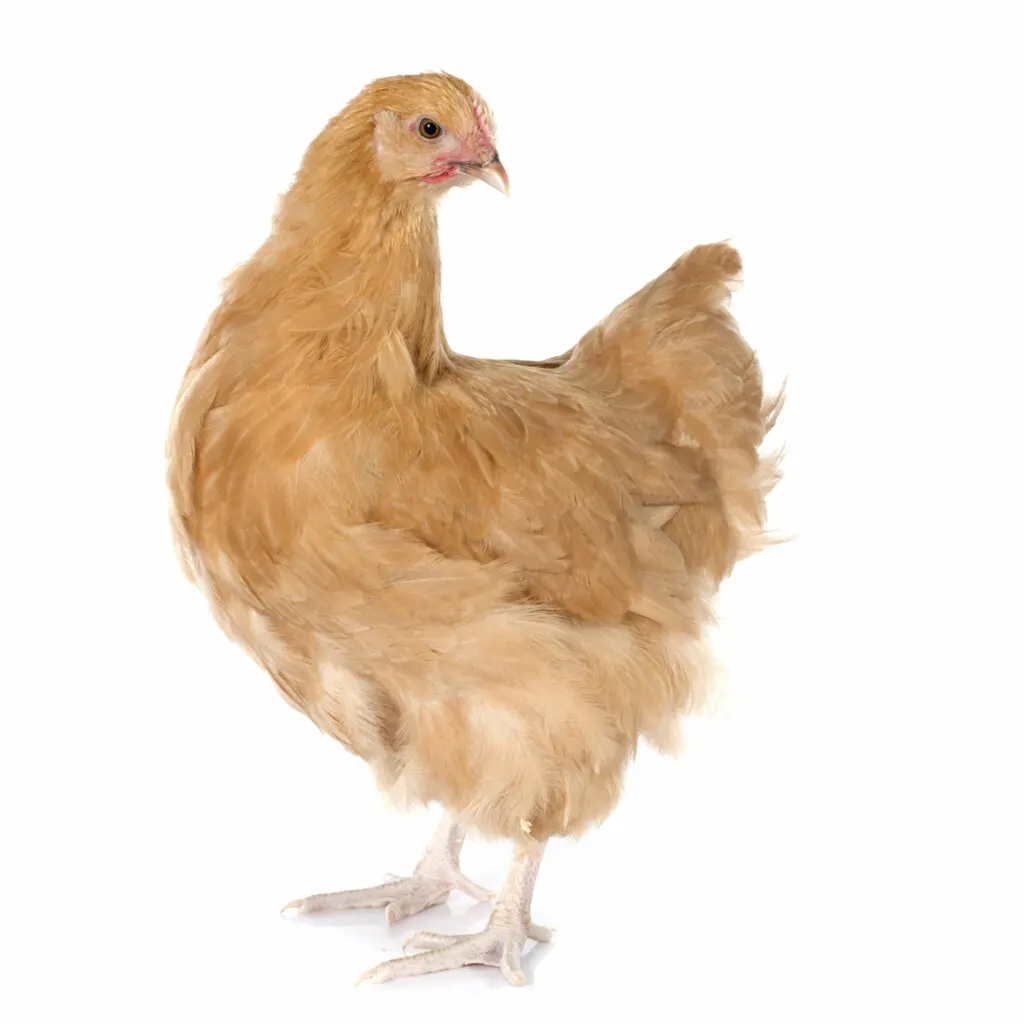
These large British birds were created by a man named William Cook in the 1880s. He crossed Black Minorcas with Black Plymouth Rocks, and crossed those with clean-legged Langshans. The result was a large, cold-hardy dual-purpose bird.
Over time, breeders shifted their focus away from production and more towards aesthetics, which resulted in a loss of quality. Today, the Orpington is a fine dual-purpose heritage breed with white skin and lays brown eggs.
These chickens come in several varieties including white, buff, black, and blue. They have medium-sized red combs that stand upright, and bright red medium-sized wattles and earlobes.
Quick Orpington Facts
- Country of Origin: Great Britain
- Weight: Males 13 lbs, Females 10 lbs
- Main Purpose: Meat and Eggs
- Egg Production: 175-200 eggs per year
- Meat Growing Time: 3 – 4 months (source)
- Recognized Color Varieties: Buff, Black, White, Blue
- Bantam Varieties: Buff White, Blue, Black
Redcap
These hardy backyard birds are popular in England, where they produce plenty of eggs and a solid Sunday dinner as well. They have somewhat plain black and brown feathering, but roosters can grow impressive combs on the tops of their heads with many defined points.
The comb is the distinguishing feature for this breed (and how they received their name).
They produce a large quantity of eggs, and can grow to a respectable 7.5 pounds for males and 6.1 pounds for females. Redcaps have blue-gray skin and lay white eggs, and require proper fencing for their enclosure (they’re known to be good fliers).
Quick Redcap Facts
- Country of Origin: United Kingdom
- Weight: Males 9.5 lbs, Females 7.5 lbs
- Main Purpose: Meat, Eggs
- Egg Production: 180-200 eggs per year
- Meat Growing Time: 4 – 6 months
- Recognized Color Varieties: One variety only
- Bantam Varieties: One variety only
Sussex
The Sussex chicken was the most popular dual-purpose chicken breed in England for over a hundred years. They come in several varieties including speckled (a favorite among fanciers), red, and white. Speckled Sussex chickens are just that – they possess a rich mahogany plumage covered in white speckles.
While these utility birds were popular in England, they never became popular in the US (likely due to their pink skin – Americans prefer yellow-skinned birds). They are, however, excellent egg-laying birds that produce tinted eggs. They are a clean-legged breed with a single comb, and medium-sized wattles.
Quick Sussex Facts
- Country of Origin: England
- Weight: Males 9 lbs, Females 7 lbs
- Main Purpose: Meat, Eggs
- Egg Production: 200 + eggs per year
- Meat Growing Time: 4 – 6 months
- Recognized Color Varieties: Speckled, White
- Bantam Varieties: Light, Red, Speckled
Mediterranean Class
Ancona
The Italian Ancona is closely related to the Leghorn, and they are also excellent layers. Hardy and tough, these Italian birds have a striking appearance and a natural alert attitude that helps them stay protected from predators.
There are two varieties of Ancona – one with a single comb, and the other with a rose comb. Both birds have interesting plumage: a black base with white mottling speckled on top.
Ancona’s are a clean-legged breed with red wattles and white earlobes. They lay a fair amount of medium to large white eggs per year.
Quick Ancona Facts
- Country of Origin: Italy
- Weight: Males 5.7 lbs, Females 4.4 lbs
- Main Purpose: Eggs, Ornamental
- Egg Production: 120 – 180 eggs per year
- Recognized Color Varieties: Single Comb and Rose Comb
- Bantam Varieties: Single Comb and Rose Comb
Blue Andalusian (Andalusian)
These slate-blue birds can trace their roots back to the ancient Romans. Named for the region of Spain known as Andalusia, these large and robust birds are less commonly found in the US.
It can be difficult for breeders to achieve the appropriate shade of blue that the breed is known for.
Blue Andalusians are large birds with distinctive slate-blue plumage. They may also be black and white (as the blue feathering is a naturally occurring genetic mutation between black and white birds), but those varieties are not allowed to be shown. They are clean-legged with impressive combs and wattles.
Quick Andalusian Facts
- Country of Origin: Spain
- Weight: Males 7.5 lbs, Females 5.5 lbs
- Main Purpose: Eggs, Ornamental
- Egg Production: 150 eggs per year
- Recognized Color Varieties: Blue
- Bantam Varieties: Blue
Catalana (Buff Catalana or Catalana del Prat Leonada)
Hailing from Barcelona, the hardy Catalana is exceptionally heat-tolerant and lays unique pinkish-hued eggs.
They are good dual-purpose chickens, but because they don’t do well in confinement, they are less suited for commercial operations. Still, they can make a good addition to a backyard flock, especially in warmer climates.
Catalanas have copper plumage and impressive single combs. The tips of their tails are greenish black, and their feet and toes are a greenish blue. They have red combs and wattles as well.
Quick Catalana Facts
- Country of Origin: Spain
- Weight: Males 8 lbs, Females 6 lbs
- Main Purpose: Eggs and Meat, Ornamental
- Egg Production: 150 – 200+ eggs per year
- Meat Growing Time: 4 – 6 months
- Recognized Color Varieties: Buff
- Bantam Varieties: Buff
Leghorn
These imported Italian birds are one of the most popular breeds of chicken around the world – and not just because there’s a wisecracking cartoon rooster with the same name.
Leghorns have always adaptable, utilitarian, and hardy. There are over 16 different varieties of Leghorns accepted by the APA, including (but not limited to) single and rose comb varieties of white and brown, buff, black, red, black tailed-red, and silver.
Leghorns are excellent layers, but provide a solid amount of meat for the table as well. Their combs are either single or rose, depending on the variety, and they lay white eggs and have yellow skin.
Quick Leghorn Facts
- Country of Origin: Italy
- Weight: Males 5.7 lbs, Females 5 lbs
- Main Purpose: Eggs
- Egg Production: 280 – 350+ eggs per year
- Meat Growing Time: 4 – 6 months
- Recognized Color Varieties: Single Comb (Dark Brown, Light Brown, White, Black, Buff, Silver, Red, Black Tailed Red, Columbian, Golden) Rose Comb (Dark Brown, Light Brown, Buff, Silver, Black, White)
- Bantam Varieties: Single Comb (Barred, Black, Black-Tailed Red, Buff, Columbian, Red, Dark Brown, Golden, Light Brown, Silver, White) Rose Comb (Black, Buff, Dark Brown, Light Brown, Silver, White)
Minorca
The largest of the Mediterranean chicken breeds, the Minorca is a formidable presence in any backyard flock.
Early Minorcas were popular with the ancient Romans, and they remain a good dual-purpose bird to this day. They lay a plentiful amount of robust eggs, but are mostly seen as an ornamental breed.
Minorcas are tall, and reach 7 – 9 pounds at maturity. They come in several different color varieties of black, white, and buff, and may possess a single or rose comb. They produce large white eggs.
Quick Minorca Facts
- Country of Origin: Spain
- Weight: Males 9 lbs, Females 7.5 lbs
- Main Purpose: Ornamental, Eggs
- Egg Production: 120 eggs per year
- Laying age: 26 weeks, large eggs at around 57 weeks
- Recognized Color Varieties: Single Comb (Black, White, Buff) Rose Comb (Black, White)
- Bantam Varieties: Single Comb (Black, White, Buff) Rose Comb (Black, White)
Buttercup (Sicilian Buttercup)
This striking ornamental bird is named for the impressive cup-shaped combs that sit like a crown on its head.
They are heat tolerant, but can have difficulty in cold climates due to their combs being susceptible to frostbite. A genetic mutation cause this breed to have almost two single combs fused together, which is why they are categorized in the “all other combs” classification.
Roosters and hens have different plumage – males have the typical reddish brown bodies and green tails that are standard in other breeds.
Hens are a golden buttery buff color with black speckles in a barred-like pattern on the body. They are clean legged and have medium sized red wattles, as well as larger white earlobes.
Quick Sicilian Buttercup Facts
- Country of Origin: Italy
- Weight: Males 6.5 lbs, Females 5.5 lbs
- Main Purpose: Eggs, Ornamental
- Egg Production: 140 – 180 eggs per year
- Recognized Color Varieties: One Variety Only
- Bantam Varieties: None
Spanish (White-Faced Black Spanish)
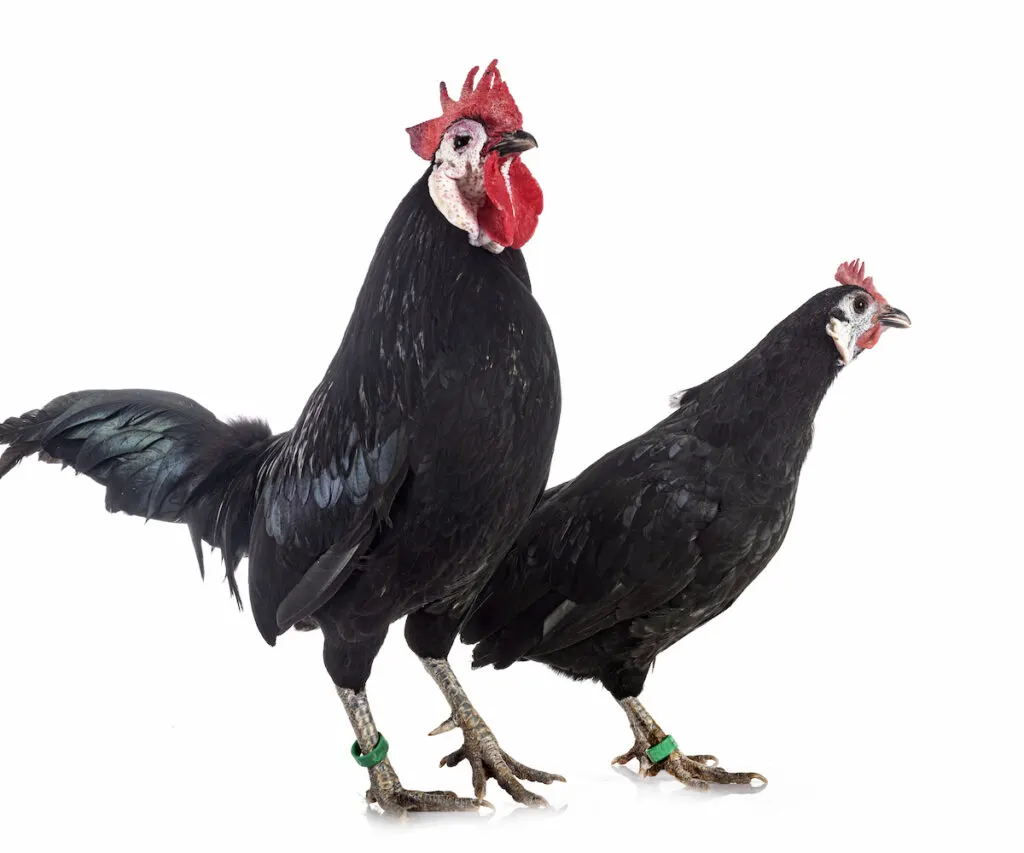
The Spanish chicken is a striking ornamental bird that is believed to be the first breed to arrive in the United States.
When the Spanish colonized the New World in the 1600s, they brought their black chickens with them, which makes the White-Faced Black Spanish one of the oldest chicken breeds in North America.
True to their name, Spanish chickens have solid black plumage and striking white faces. They have single red combs with well-defined points, and long red and white wattles.
Spanish hens lay a fair amount of large white eggs per year, but are generally considered an ornamental bird.
Quick Spanish Facts
- Country of Origin: Spain
- Weight: Males 8 lbs, Females 6.5 lbs
- Main Purpose: Ornamental, Eggs
- Egg Production: 160 – 180 eggs per year
- Recognized Color Varieties: White-Faced Black
- Bantam Varieties: White-Faced Black
Oriental Class
Aseel
These tall athletic birds were developed specifically for fighting – in fact, male chicks are known to engage in battle almost immediately after hatching.
They can be very aggressive, but hens often make excellent mothers. The Aseel is a decently sized game bird, but is not a generally good choice for a beginner with a backyard flock.
Tall and lanky, the Aseel stands tall and upright. They come in several varieties, and some have beautiful multicolored plumage. They have small red combs, but no wattles. The Aseel is not a good layer – only producing 5 – 50 eggs per year.
Quick Aseel Facts
- Country of Origin: India, Pakistan
- Weight: Males 5.5 lbs, Females 4 lbs
- Main Purpose: Meat, Sport (although fighting is illegal in the United States)
- Meat Growing Time: 4 – 6 months
- Recognized Color Varieties: Black-Breasted Red, Dark, Spangled, Wheaten, White
- Bantam Varieties: None
Cubalaya
The Cubalaya is an all-purpose breed from the tropical island of Cuba, used for meat, eggs, and sport. They are not as aggressive as some other fighting breeds, and their primary purpose is to provide eggs and meat.
The Cubalaya is a good layer, tolerant of a hot and humid climate, and provides a decent amount of meat for the table.
They come in three varieties – the black breasted red, white, and black. They have an interesting appearance, with elegant plumage ad a unique “lobster-tail” of thick feathers trailing beyond their backs. They have medium-sized red combs and wattles, clean legs, and lay small white eggs.
Quick Cubalaya Facts
- Country of Origin: Cuba
- Weight: Males 6 lbs, Females 4 lbs
- Main Purpose: Meat and Eggs, Ornamental (also Fighting)
- Egg Production: 125 – 175 eggs per year
- Meat Growing Time: 3+ months
- Recognized Color Varieties: Black, Black Breasted Red, White
- Bantam Varieties: Back, White, Black Breasted Red, White
Malay
This tall, prehistoric-looking game bird is an ancient breed from India. Primarily raised for meat, the Malay is the tallest of the chicken breeds – roosters can reach over 3 feet tall!
Long and upright, they are also known for their “beetle brows,” which are bony projections over the skull that give the bird a somewhat ornery appearance.
Malay chickens have strawberry combs set across the brow, and small red combs and wattles. Hens are generally good mothers, but lay eggs infrequently.
Quick Malay Facts
- Country of Origin: Southeast Asia
- Weight: Males 9 lbs, Females 7 lbs
- Main Purpose: Meat, Ornamental
- Meat Growing Time: 4 – 6 months
- Recognized Color Varieties: Black, Black Breasted Red, Red Pyle, Spangled, Wheaten, White
- Bantam Varieties: Black, Black Breasted Red, White, Red Pyle, Spangled, Wheaten (female)
Phoenix
These beautiful ornamental birds are known for their elegant long tails – a Phoenix rooster’s tail can reach several feet long! Bred in Germany by crossing native game birds with Japanese Onagadori.
The Phoenix was further refined in the United States to improve its hardiness, as the early Onagadori crosses were somewhat delicate birds.
The Phoenix comes in golden and silver varieties recognized by the APA, although more exist. They have long feathers, clean legs, and prominent red combs and wattles.
Quick Phoenix Facts
- Country of Origin: Germany
- Weight: Males 5.5 lbs, Females 4 lbs
- Main Purpose: Ornamental
- Recognized Color Varieties: Golden, Silver, Black Breasted Red
- Bantam Varieties: Golden, Silver
Shamo
The Shamo is the second-tallest chicken breed, and they closely resemble their lanky cousins, the Malays. This ancient breed was developed in Japan, imported into the united states in the late 1800s primarily for fighting.
Like the Malay, the Shamo is tall and leggy, and possesses the same “beetle brow”, although their body types differ slightly. They are also slightly shorter and lighter, as well.
Male Shamos are also quite aggressive towards other chickens, but can be tamed by humans. They have small pea combs, small wattles, and no feathers on their heads or faces.
Quick Shamo Facts
- Country of Origin: Japan
- Weight: Males 11 lbs, Females 7 lbs
- Main Purpose: Meat, Ornamental, Fighting
- Egg Production: 60 – 100 per year
- Meat Growing Time: 4 – 6 months
- Recognized Color Varieties: Black, Dark, Black Breasted Red, Wheaten
- Bantam Varieties: Wheaten, Black, Black Breasted Red
Sumatra
These beautiful birds from Indonesia were originally imported to the US for fighting. They are excellent fliers – arguably one of the best flying breeds.
Backyard enthusiasts will likely need covered pens, as they can also jump six feet or more (even with clipped wings).
These stylish birds have striking black plumage and inquisitive expressions. They have long, prominent tails and glossy feathers and feet.
Males have a cluster of spurs on each leg, and they have very small pea combs and wattles.
Quick Sumatra Facts
- Country of Origin: Sumatra, Java (Indonesia)
- Weight: Males 5.5 lbs, Females 4 lbs
- Main Purpose: Ornamental, Eggs
- Egg Production: 100+ eggs per year
- Recognized Color Varieties: Black, Blue
- Bantam Varieties: None
Yokohama
This ornamental breed has exceptionally long feathers, ending in elegant tails. They are small and relatively docile, bred mainly for their striking plumage rather than eggs or meat.
The Yokohama was developed in Germany in the late 1880s from imported long-tailed Japanese breeds.
There are two varieties in the APA – the white, and the red-saddled. The white variety is completely white, with red combs and wattles.
The red-saddled variety has white plumage, but with deep red saddle plumage. They have clean legs and lay small brown eggs.
Quick Yokohama Facts
- Country of Origin: Germany
- Weight: Males 5 lbs, Females 3 lbs
- Main Purpose: Ornamental
- Egg Production: 80+ per year
- Recognized Color Varieties: Red Shoulder, White
- Bantam Varieties: None
Miscellaneous Class
Ameraucana
The Ameraucana was developed in the 1970s from imported South American Araucanas. They are best known for laying unusual blue-colored eggs like the Araucana, but without the genes that cause chicks to die during incubation.
Used mostly by hobby farmers for eggs, they have an impressively long laying season, laying well into the late fall and starting up again in very early spring. They’re a medium-sized breed, and come in many different colorful varieties.
The Blue Wheaten Ameraucana has particularly interesting plumage, consisting of several shades of blue feathers with striking orange feathers on its back and head. Ameraucanas have pea combs, small wattles, and red earlobes.
Quick Ameraucana Facts
- Country of Origin: United States
- Weight: Males 6 lbs, Females 5 lbs
- Main Purpose: Eggs
- Egg Production: 250 eggs per year
- Recognized Color Varieties: Black, Blue, Blue Wheaten, Self Blue, Brown Red, Buff, Silver, Wheaten, White
- Bantam Varieties: Black, Blue, Buff, Silver, Wheaten, White, Blue Wheaten, Brown Red
Araucana
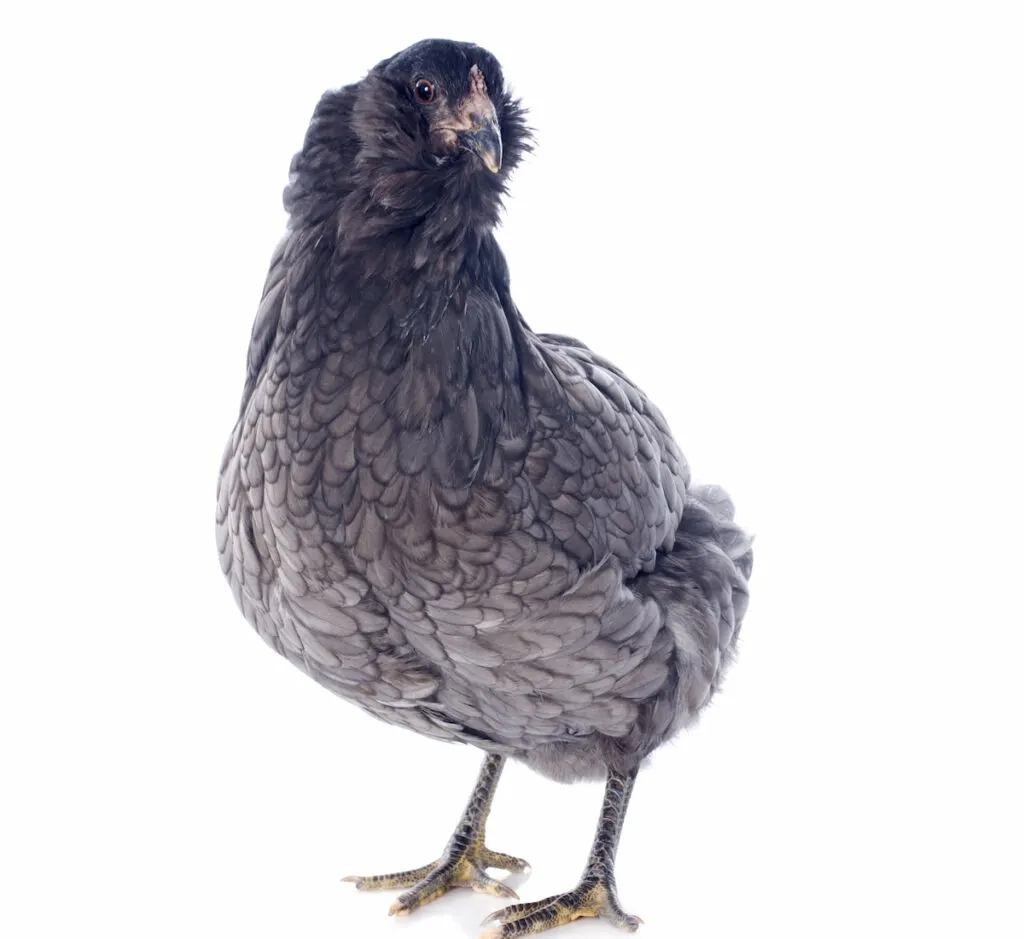
These unique birds from Chile were developed in the early 1900s. The Araucana is known for its colorful eggs, which can range in shade from blue to greenish blue. When the Araucana is crossed with other birds, the offspring may produce yellow, green, or even pink eggs.
They come in several colorful varieties including Black, Black-Breasted Red, Blue, Buff, Golden Duckwing, Silver, Silver Duckwing, and White. Unlike other chickens, they don’t have tails, and their ears are hidden behind tufts of feathers that are shaped like earrings. They have small combs, small wattles, and their earlobes are small and bright red underneath that tuft of feathers.
Quick Araucana Facts
- Country of Origin: Chile
- Weight: Males 6.6 lb, Females 5.5 lb
- Main Purpose: Eggs
- Egg Production: 150-180 eggs per year
- Recognized Color Varieties: Black, Black Breasted Red, Dark, Spangled, Wheaten, White
- Bantam Varieties: Black, Black Breasted Red, Golden Duckwing, White Silver Duckwing
Naked-Neck (Transylvanian Naked-Neck, Turken)

The Naked-Neck lives up to its name – not only are their necks devoid of feathers, but they also possess around 40-50% of the amount of feathers that most chickens have covering their bodies.
Despite looking a little scraggly (some would even say they’re ugly), this lack of feathering allows them to be well-adapted to hot climates.
However, they can also do well in cooler temperatures as well. The Naked-Neck is hardy, healthy, tough, and efficient. Because producing feathers requires extra protein, these naked chickens are very efficient.
Turkens require less protein (and less food) to grow and produce eggs. A good dual-purpose bird, they produce a good amount of eggs and are easy to pluck.
Naked necks come in four varieties: black, buff red, and white. They have large red combs and wattles, and they lay brown eggs.
Quick Naked Neck Facts
- Country of Origin: Eastern Europe (Hungary, Romania)
- Weight: Males 8.5 lb, Females 6.5 lb
- Main Purpose: Eggs, Meat
- Egg Production: 150+ eggs per year
- Meat Growing Time: 3-5 months
- Recognized Color Varieties: Black, Buff, Red, White
- Bantam Varieties: White, Buff, Red
Sultan
These ornamental birds were first bred in Turkey, primarily to be kept as showy pets. They are fairly small, and have striking plumage with impressive tufts atop their heads. Sultans are generally white, but may also be black or blue.
These birds are friendly and make good pets, but they also lay a respectable amount of eggs as well. They do well in confinement, as free-range Sultans may have problems maintaining the quality of their long feet feathers.
Underneath their thick tufts, Sultan’s have small v-shaped combs, small wattles, and red earlobes.
Quick Sultan Facts
- Country of Origin: Turkey
- Weight: Males 6 lb, Females 4 lb
- Main Purpose: Eggs, Ornamental
- Egg Production: 150 – 200 eggs per year
- Recognized Color Varieties: White
- Bantam Varieties: White
Game Class
Modern Game
After cockfighting became illegal in England, breeders developed birds that were strictly for showing. The Modern Game developed from crossing Old English Game birds with tall, lanky Malays.
Despite generally being an ornamental bird, they still produce a decent amount of eggs.
Modern Games are tall and stately looking, and they come in a variety of colors and patterns.
Modern game chickens aren’t terribly cold-resistant, and may require an insulated building in the colder climates. They have small single combs, and small red wattles and earlobes.
Quick Modern Game Facts
- Country of Origin: England
- Weight: Males 6 lb, Females 4.5 lb
- Main Purpose: Ornamental (Eggs)
- Egg Production: 100+ eggs per year
- Recognized Color Varieties: Birchen, Black, Black Breasted Red, Brown Red, Golden Duckwing, Black, Red Pyle, Silver Duckwing, Wheaten, White
- Bantam Varieties: Black, Blue, Birchen, Red Pyle, Splash, Wheaten, Black Breasted Red, Blue Breasted Red, Brown Red, Golden Duckwing, Lemon Blue, Silver Blue, Silver Duckwing, Ginger Red
Old English Game
These sporty little birds were originally bred in England for fighting. In modern times, they are a mostly ornamental breed, but they can provide a respectable amount of eggs and meat as well.
These birds are attractive and come in more color varieties than any other breed. If you’re looking for a unique, sporty little bird, consider the Old English Game.
Male chickens can be aggressive, so it’s generally best to separate them as soon as they hatch. They are also good fliers, and very active.
Old English game birds have small upright combs with distinct points, and small wattles. These are often removed from male birds if they are shown.
Quick Old English Game Facts
- Country of Origin: England
- Weight: Males 5 lbs, Females 4 lbs
- Main Purpose: Ornamental (occasionally eggs and meat)
- Egg Production: 120+ eggs per year
- Recognized Color Varieties: Black, Crele, White, Spangled, Self Blue, Red Pyle, Brown Red, Lemon Blue, Black Breasted Red, Blue Breasted Red, Blue Golden Duckwing, Blue Silver Duckwing, Golden Duckwing, Silver Duckwing
- Bantam Varieties: Black, Birchen, Blue, Brassy Back, Brown Red, Crele, Columbian, Cuckoo, Ginger Red, Blue Brassy Back, Blue Breasted Red, Blue Golden Duckwing, Blue Silver Duckwing, Fawn Silver Duckwing, Black Breasted Red, Black Tailed Buff, Golden Duckwing, Lemon Blue, Mille Fleur, Quail, Red Pyle, Self Blue, Silver Blue, Silver Duckwing, Spangled, Wheaten, White, Blue Wheaten
Additional Chicken Breeds not Recognized by the APA
Ayam Cemani
These unique birds are black – their plumage, combs, wattles, and even their internal organs are black! This distinctive coloring is caused by a dominant gene that causes hyperpigmentation (a genetic condition called fibromelanosis).
Developed in Indonesia, they are commonly found at market fetching between $50 and $2,500. However, they are a rare breed in the United States, and are not yet recognized by the APA.
Quick Ayam Cemani Facts
- Country of Origin: Indonesia (Java)
- Weight: Males 5.5 lb, Females 4.4 lb
- Main Purpose: Ornamental, Medicinal, Mystical
- Color Varieties: Black (including internal organs!)
Red and Black Sex-link Chickens
The red or black sex-link chicken isn’t technically a breed at all, but rather a description of a hybrid. “Sex-links are crossbred chickens whose color at hatching is differentiated by sex.” This makes it easier to tell whether your chick is a male or female at birth.
Crossing a Rhode Island Red or New Hampshire rooster with a White Rock, Silver Laced Wyandotte, Rhode Island White, or Delaware hen produces a red sex-link chicken. Black sex-links are often produced by crossing special strains of Rhode Island Red roosters and Barred Rock hens (but others may be used as well).
Because this term describes several different crossbreeds, they often vary greatly in appearance. However, they are often medium-sized with reddish or black plumage, clean-legged, single-combs, and small wattles.
Crossbreeds often exhibit “hybrid vigor,” which means that they tend to be hardy and prolific egg-layers. Because they are easily sexed at birth and possess excellent egg-laying abilities, they are often chosen for commercial laying operations. They also grow quickly, and begin laying eggs at a younger age than their purebred counterparts. (source)
Specific Types of Sex-link Chickens
| Type | Male Parent Breed | Female Parent Breed | |
|---|---|---|---|
| Red | Red Star | New Hampshire or Rhode Island Red | Plymouth Rock, Rhode Island White, Silver Laced Wyandotte, or Delaware |
| Red | Golden Comet | New Hampshire | White Plymouth Rock |
| Red | Cinnamon Queen | New Hampshire | Silver Laced Wyandotte |
| Red | ISA Brown | Rhode Island Red | Rhode Island Whites |
| Black | Black Rock | Rhode Island Red | Barred Rock |
| Black | Black Star | Rhode Island Red or New Hampshire | Barred Rock |
Quick Sex-link Facts
- Country of Origin: United States
- Weight: varies, but is generally medium-sized (6-7 pounds)
- Main Purpose: Eggs, Meat
- Egg Production: varies, but can often exceed 300+ eggs per year
Easter Egger
The Easter Egger is not technically recognized by the APA as a breed. Wikipedia describes the Easter Egger as “any chicken that possesses the “blue egg” gene, but doesn’t fully meet any breed standard defined in the American Poultry Association’s (APA) standards.
The name derives from the resemblance of their colorful eggs to Easter eggs and for many years most hatcheries mistakenly labeled their Easter eggers as Ameraucanas or Araucanas.”
Easter Eggers may resemble Ameraucanas, Araucanas, or any breed in between. They lay a variety of beautiful eggs that range in shade from blue, green, or even pink!
If you cross an Easter Egger with a bird that lays dark brown eggs (like the Maran), the offspring may end up laying olive-green colored eggs. These are sometimes referred to as “olive-eggers.”
Easter egger chickens may not breed true as far as egg color. As such, you may get a wide variety of egg colors from your flock as pictured below.
Showgirl Chickens (Silkie/Turken Cross)
These fancy-looking divas are not technically a breed that is recognized by the APA, but they’re sure to turn heads wherever they go. The Showgirl chicken is a cross between a bantam Silkie and a Turken (or Naked-Neck).
These chickens possess the interesting characteristics of both breeds – the uniquely “naked neck” of the Turken, and the fluffy silken feathers of the Silkie.
Used mostly as a backyard breed, they are also respectable layers as well. Because the Showgirl is a crossbreed, they can somewhat vary in appearance.
However, most Showgirls have black skin, long skinny necks devoid of feathers, and are covered in fluffy feathers that end in impressive crests atop their heads. (source, source)
Quick Showgirl Facts
- Country of Origin: United States
- Weight: Males 4 lbs, Females 3 lbs
- Main Purpose: Ornamental, Eggs
Notes and References….
All meat growing times are approximate. Heritage chickens are slow-growing, on average, and may take much longer to mature to full size. However, many enthusiasts agree that slower-growing chickens are best harvested between 12 and 20 weeks of age.
Other Sources:
Chicken Weights: How Much Chickens Weigh
Harvest Times: https://morningchores.com/meat-chickens/, https://bestfarmanimals.com/best-chickens-to-raise-for-meat-fast-growth-great-flavor/
Overall Information Sources:
- Livestock Conservancy Heritage Chicken Chart
- Livestock Conservancy, Poultry
- Storey’s Illustrated Guide to Poultry Breeds (Ekarius, Carol. 2007)
- American Poultry Association
- Wikipedia
- An excellent resource for choosing chicken breeds: https://livestockconservancy.org/index.php/heritage/internal/chicken-manual
